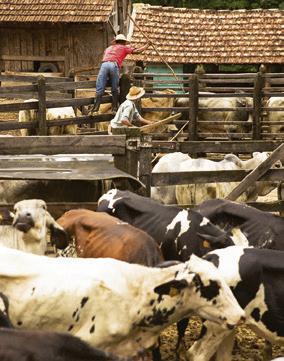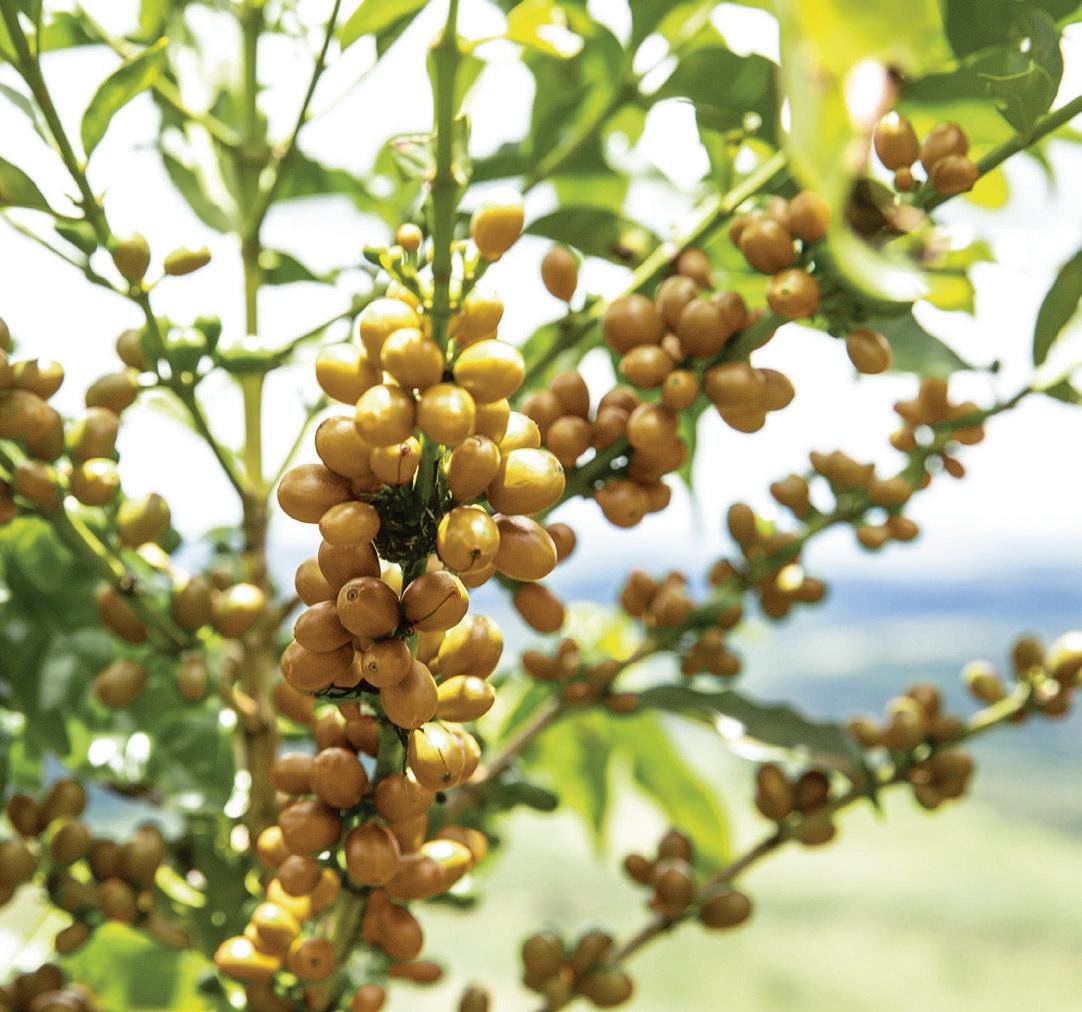
9 minute read
COFFEE CULTURE
LAND OF THE fazendas
BRAZIL HAS SHARED ITS HISTORY WITH COFFEE FOR TWO HUNDRED YEARS. A FEW HOURS FROM RIO, CENTURIES-OLD ESTATES STAND AS TESTAMENTS TO THE MANY ERAS THAT FORGED THE SINGULAR CHARACTER OF THIS MAJOR PRODUCER COUNTRY, AND DO SO TO THIS DAY.
By Guillaume Jan Photos Jean-Christophe Husson



FAMILY FARM “Chico”, manager of Fazenda Sertão, amid the coffee trees planted by his ancestors.
FAR WEST Fazenda lands are used only for coffee growing and cattle breeding.

“THIS IS OUR ESTATE, FAZENDA SERTÃO,A 250-HECTARE COFFEE PLANTATION. And on this hillside, the Bourbon coffee trees you see there were planted over a hundred years ago!” A flock of budgerigars fly boisterously over the fields streaked with dark green bushes. The curvaceous hills seem to roll endlessly to the horizon. The agitated sky murmurs its threats of rain. Francisco Isidro Dias Pereira quickly scans the moody clouds, frowns, then continues: “My grandfather, José Isidoro, was one of the first Minas Gerais settlers to start working with coffee back in 1910. He understood how the soil was good for coffee-growing, being so rich with minerals, at more than 1,150 metres’ altitude, with a climate cooler than down on the coast.” Francisco – who goes by “Chico” –has spent his entire life at Fazenda Sertão, having been born here in 1950. He played among the coffee trees gracefully tracing the morros (“hills”) before working the land when he was older, then becoming administrator for this family business that has developed over four generations. “My grandparents were determined to produce quality harvests,” remarks the cowboyish sexagenarian in faded jeans, a battered hat and moustache. “They planted Yellow Bourbon [a variety of Arabica], which I think is the best coffee and now constitutes 45% of our produce. And they wanted to preserve the woodlands to ensure some biodiversity remained on the estate. We’ve carried on that tradition by fallowing land every other year, which ensures high productivity with minimal external interference.”
THE WORLD’S BEST COFFEE
The vast, hushed spaces of Fazenda Sertão stand in dramatic contrast to the hubbub of Rio de Janeiro some 350 kilometres away. It takes a good day’s drive to reach the village of Carmo de Minas, traveling along the banks of

RARE GEMS The Yellow Bourbon grown on these Minas Gerais lands enjoys a climate and soil ideal for coffee trees.
tempestuous streams, traversing dreary villages, crossing over a mountain pass, then meandering a few kilometres more into the countryside before coming across the discreet entrance to this prestigious fazenda. “We have no choice but to produce Today, the Pereira family is reaping the benefits of this choice, since it can boast of producing one of Brazil’s most Here, dered the by plots of hedges coffee trees of banana are bortrees or quality coffee” exceptional co adds, “In 2005, ffee the s. Chico proudly Cup of Excellence cedars, and groves of eucalyptus dot the landscape. “The countryside here Francisco Isidro Dias Pereira even awarded us the highest ever given in the world.” rating is so hilly that we can’t harvest our We suddenly feel a strong desire to crops mechanically,” says Chico. “Everything is done man- sample this precious nectar. Chico has us get back in the ually. So when picking time comes, the estate employs as bed of his old pickup and drives us along the plantation’s many as 600 people! Since labour is expensive, we have no muddy trails to the family home. He brings out an enamchoice but to produce quality coffee, 100% Arabica, which elled metal coffee pot and serves his ebony treasure with the sells at a higher price than the Robusta grown on the plains.” flowery attack that softens into a mild, balanced, slightly bitter flavour. Outside, the skies finally open and the rain streams down. Comfortably sheltered in the rustic, wooden home, Chico takes advantage of our being housebound to trace the history of Brazilian coffee. It was in the early 19th century •••

FAZENDA SERTAO CARMO DE MINAS
BRASIL
RIO FAZENDA PONTE ALTA BARRA DO PIRAÍ
RIO DE JANEIRO



FROM CHERRY TO CUP At Carmo de Minas, Fazenda Sertão performs the various coffee-processing steps.
that the plantations began their boom. Starting in 1831, Brazil became the world’s largest exporter, the number of plantations grew and the country “Brazilian is entering coffee growers went deeper inland, into experienced nomic expan two sion decades of in the 1850s ecoand a new era.” Minas Gerais, the and Paraná, in the São sou Paulo re th.” This gion was 1860s African due to slaves. the massive arrival Production slowed of in Luiz Paulo Dias Pereira Filho a new period biggest coffee of prosperity barons, who s for the tripped the 1880s with the laws abolishing bare a still-pristine natural landscape slave trade, but also because of a string of harsh winters that to cultivate excellent coffees that were exported worldwere deadly for the crops, most certainly compounded by the wide. But everything changed in 1952, when the Instituto depletion of agricultural soils caused by short-term profitability Brasileiro do Café (IBC) imposed low prices on all producers objectives. “My grandfather got started in coffee during the and enacted regulations that favoured production quantity second great era of Brazilian coffee, which began in 1910 rather than production quality. “For forty years, until the IBC and ended in the early 1950s,” continues Chico. “Those new closed down in 1989, Brazil suffered greatly on account of this policy. After that, we worked hard to rebuild our reputation. We were inspired by the winegrowing culture to create designations of origin and vintages. I’ll drive you over to see my nephew, Luiz – he’ll tell you what you need to know about how things are nowadays.”

NUMBER ONE Hélcio Pereira da Silva Júnior reminds us that Brazil is the world’s leading coffee producer.
A NEW ERA
The tropical downpour has ended, the puddles already evaporating in the sunshine. We leave the fazenda to drive to the village of Carmo de Minas. The laboratory of the Carmo Coffees company (the exporting branch of Sertão Coffees) is at the top of a cobbled street, near the church. “Brazilian coffee has entered a new era in which quality is receiving greater attention,” explains Luiz Paulo Dias Pereira Filho, sitting in his office cluttered with metal boxes. “Not only are we working on the taste of our coffees, but we’re doing a better job of handling issues of corporate social and environmental responsibility and improving the traceability of our beans. And this work we’ve done means we now export to 35 countries and today are partnering with prestigious customers, like Nespresso.” The Sertão company is indeed one of Nespresso’s suppliers of Yellow Bourbon, used in the Grand Cru Dulsão do Brasil, for example. This is proof that the bean quality and plantation management meet the standards of the Swiss brand and its AAA Program (see inset next page).
A heady aroma of coffee permeates the office: this is the time when the sacks are selected based on customers’ tastes. As we descend the small staircase to the laboratory, where we will watch employees roast a few beans, then sip from several cups before rating each brew, Luiz expresses his confidence in the future. “The ‘gourmet coffees’ are making headway in Brazil, but they still only account for two million bags out of the 50 million produced each year across the territory. There’s huge development potential for these high-quality coffees.”
His cousin, Hélcio Pereira da Silva Júnior (photo), agrees: He is Sales Director for the cooperative known as Unique Cafés (the branch of Sertão Coffees) that roasts and distributes the fazenda’s coffee across the country. “While •••
TRADITIONAL PLANTATION Fazenda Ponte Alta takes visitors back to the era of the 19th century.

NESPRESSO AAA PROGRAM: POSITIVE AT EVERY LEVEL
To guarantee production of quality coffee with positive environmental and social impact for growers, the fazendas that Nespresso selects are committed to respecting the AAA Sustainable Quality™ Program. This program, in place in the state of Minas Gerais since 2005, invites coffee growers to be more rigorous in selecting their coffee beans by methodically eliminating green cherries (those not yet of sufficient maturity) and developing more proactive sun-drying techniques. Employees enjoy better working conditions, as well (wages, hours, housing), and environmental issues are closely monitored. Ecosystems and biodiversity are protected to preserve local water resources and prevent soil erosion.
producers are becoming more exacting about quality, consumers are choosing to drink better coffees. So we help them in refining their tastes by suggesting partner retail outlets where they can come learn about new flavours and get information on this product that’s so essential to the history of our country.”
EDUCATIONAL TOURS
Two hundred kilometres away, on the road back to Rio, in the valley of the Paraíba River, Roberto Freitas puts on his educator’s cap to explain coffee’s prominent place in the development of Brazil and the vital role that black slaves played in that construction. This former accountant became fascinated with the era of the first fazendas, to the point of actually stepping into the shoes of a great, 19th-century proprietor. In his coffee-baron costume, he conducts daily historic re-enactments for students from the surrounding area

HISTORY LESSON “Baron” Freitas recalls the role of slaves in the construction of Brazil.

or tourists that stop at the Fazenda Ponte Alta, in the town of Barra do Piraí. “We are on the lands of the first great coffee era. My educational tours show who really built this country and under what conditions,” declares this “We are on the lands of the first great ing the senzalas, the cells that the slaves were crammed into. The plantation had up to 800 of them when the coffee economy was in full swing. history buff, while taki the estate built in 1830 ng on us 1,8 around 00 heccoffee era.” Brazil was the la the practice, bac st k Christian in 1888.” country to abolish tares of land. imposing, with The soft site green is vast and hills, animal Roberto Freitas is This morning, a observing “Bar class from a on” Freitas’ nearby school performance. herds driven by cowboys on horse- The schoolchildren hold their breath during the back, period buildings bordered by Imperial palm trees. The staging of the day-to-day experience of the workers – the inn (pousada) portion of the fazenda is home to four large skin colour of these adolescents suggests that they are, for guestrooms and a reputable restaurant for visitors wanting to the most part, descendants of slaves. But, the moment the explore the historic routes of Brazilian coffee. “Ponte Alta is performance is over, the students scatter happily across the the only fazenda that still has all its original buildings, includ- green grass and begin a spontaneous game of football. On the shady porch, Roberto Freitas listens to their reactions and their laughter. “This facet of history isn’t taught in the schools. It been 130 years since abolition: I think it’s time to talk about it.” n










